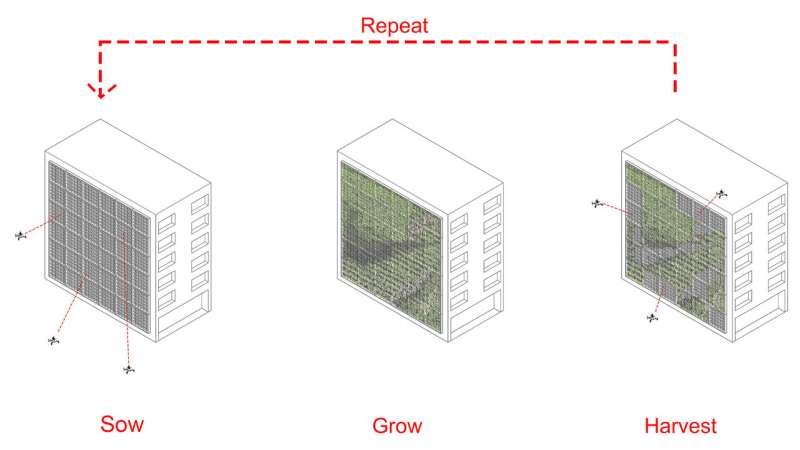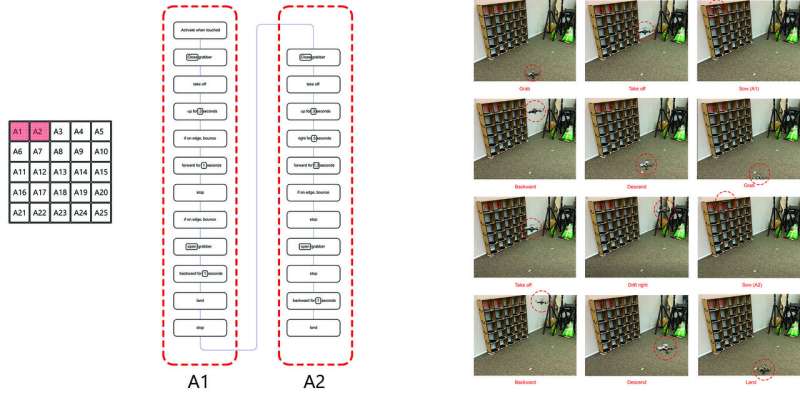May 22, 2019 feature
PixelGreen: A hybrid, green media wall for existing high-rise buildings

Researchers at Deakin University and the University of Hong Kong have recently designed a hybrid green architectural wall system for high-rise buildings that integrates a vertical micro-farm and a media screen. They presented this wall, called PixelGreen, in a paper published on Research Gate. PIXEL GREEN is designed for integration into the wall surfaces of existing buildings, turning them into analogue media screens.
"In this research, we explore the opportunity for new design possibilities to achieve a hybrid architectural wall system as a reciprocal retrofit for existing high-rise buildings surfaces, integrating a vertical micro-farm and media screen," Chin Koi Khoo and H Koon Wee, the two researchers who carried out the study, told TechXplore via email.
In this age of intense urbanization, a vast amount of arable land has been taken up by cities, which has significantly reduced the amount of crops produced every year. This could lead to a significant shortage of food, which might cause serious issues over the next few decades. Researchers have thus been trying to come up with alternative ways to produce crops, one of which is an interesting solution called "vertical farms."
Vertical farms and gardens are essentially buildings (e.g., skyscrapers) in which crops are grown in vertically stacked layers. This practice has recently gained popularity, particularly in densely populated urban environments. In addition to increasing the production of crops, vertical farms could foster a greater sense of community.

"The city, as we know it, is highly privatized, and vertical skyscrapers are not really relating to each other," Wee explained. "With the idea of vertical farming, the next step in my research is to identify podium roofs at a lower level or fire refuge floors required for maintenance and harvesting. These new horizontal levels will serve as communal and recreation spaces, because farms will always need staging areas to connect a number of vertical farms. Therefore, bringing back farming also means bringing back a certain village organization of cooperation and community, which can help cities address how private property owners tend to fiercely guard their spaces."
Vertical farms are usually designed from scratch, so building them can be quite expensive. In their study, Khoo and Wee set out to develop a hybrid media and vertical farm wall that can be applied to existing buildings and architectural structures. Their wall, called PixelGreen, exploits wall surfaces as analogue media screens, using vertical farms and gardens as a medium of representation.
PixelGreen can be retrofitted to the walls of existing high-rise buildings to convey media-based, graphical and artistic content, simultaneously enabling the micro-farming of edible plants. This green wall could thus have numerous possible applications. For instance, it could be used as a pop-up façade farm, as an analogue architectural media screen and/or as a "vertical park" for existing buildings.
Khoo and Wee's design is unique and has many advantages that set it apart from similar technologies. First, it fully exploits the vertical surfaces of existing buildings. Second, PixelGreen is a highly flexible and adaptable environmental media wall with a sustainable life cycle. Finally, it is fairly easy to implement, thus allowing those installing it to make substantial changes in urban environments over short periods of time.

"The promising outcomes generated in this research will eventually lead to a demonstration of large-scale architectural interface in a dense urban area with commercial, social and environmental value," Khoo and Wee said. "The practical implications will include the autonomous hybrid green media wall, façade farming and interactive urban interface."
As a proof-of-concept, Khoo and Wee developed a modular mock-up of their media wall. This mock-up also features a programmed unmanned aerial vehicle (UAV), which constantly updates media content on the screen, performs regular maintenance and establishes a steady farming cycle. In their paper, the researchers also provide preliminary guidance on how to feasibly introduce PixelGreen within urban environments.
"In our future work, we plan to merge PixelGreen with social interactions through commercial and art installations, to adopt an approach that integrates horizontal (roof) and vertical (wall) surfaces of existing urban infrastructure and exploit these surfaces even further," Khoo and Wee said.
Wee is also currently working on another research project related to urban policy, ownership and social issues surrounding urban farming, which is supported by the Hong Kong Government Research Grant Council (RGC) Grant. He is studying urban aspects by identifying the barriers that may prevent the establishment of a networked and collaborative urban farm. According to Wee, this idea is still decades away from achieving widespread acceptance, primarily because imported cheap food is still readily available.
"Food security only becomes a problem when more protectionist trade policies are set up against globalization," Wee adds. "To be fair, globalization is great, but it has also trampled all over the world for exotic goods and cheap labor. Having a portion of our food produced locally will help bring a new set of values to our citizens. We will be more aware about our nutrition, and have a better understanding of what goes into the making of our food, from the consumption of water, use of chemicals to labor and economy issues. This will create better health in our food intake and improve our social state as well. In short, urban farming allows us to rethink our highly privatized and urban society."
More information: PIXELGREEN: A hybrid green media wall for existing high-rise buildings. www.researchgate.net/publicati … _high-rise_buildings
© 2019 Science X Network

















